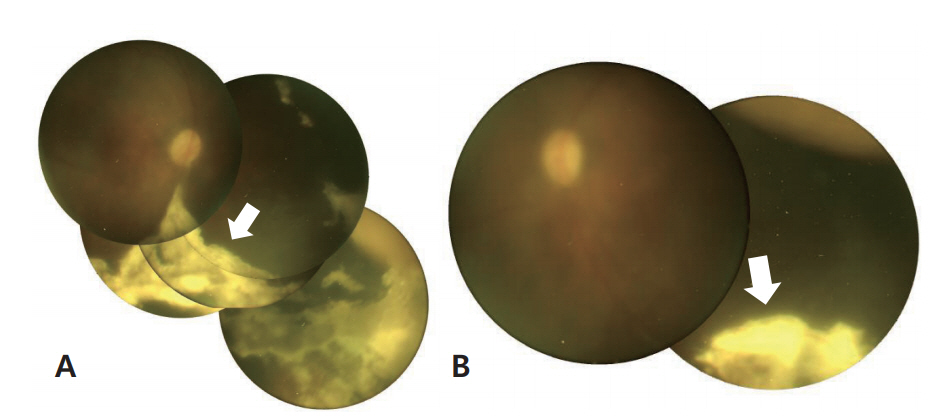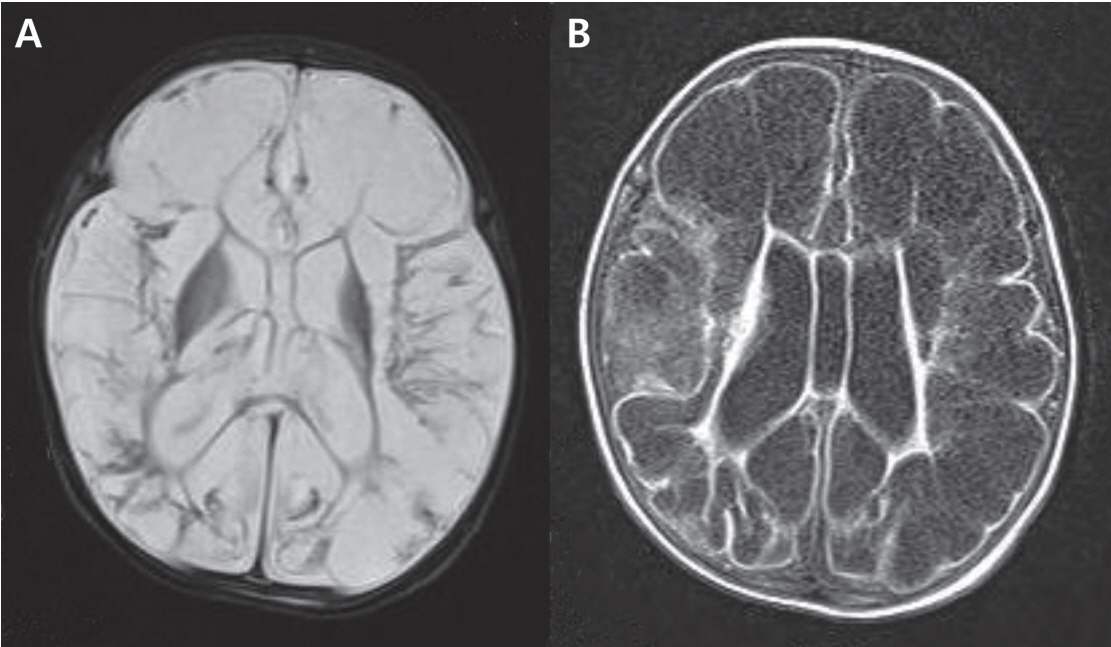Neonatal Med.
2019 Feb;26(1):63-66. 10.5385/nm.2019.26.1.63.
Bilateral Acute Retinal Necrosis and Encephalomalacia Due to Herpes Simplex Virus Infection in a Premature Infant
- Affiliations
-
- 1Department of Pediatrics, Pusan National University Hospital, Pusan National University School of Medicine and Biomedical Research Institute, Busan, Korea. kuma2002@hanmail.net
- 2Department of Pediatrics, Pusan National University Children's Hospital, Pusan National University School of Medicine, Yangsan, Korea.
- 3Department of Ophthalmology, Pusan National University School of Medicine, Yangsan, Korea.
- 4Biomedical Research Institute, Pusan National University Hospital, Busan, Korea.
- KMID: 2440702
- DOI: http://doi.org/10.5385/nm.2019.26.1.63
Abstract
- Herpes simplex virus (HSV) is a common pathogen, that causes a broad spectrum of diseases, ranging from minor skin infections to severe encephalitis and widespread infections. Acute retinal necrosis (ARN), one of the most serious manifestations of HSV infection, is defined as a rapidly progressing necrotizing retinopathy that presents discrete areas of circumferential retinal necrosis, along with signs of uveitis, vitreitis, and retinal vasculitis. We encountered a case of a female infant, born at 33 weeks of gestation with a body weight at birth of 2,080 g, who had ARN and encephalomalacia due to HSV infection. ARN associated with HSV infection should be suspected when nonspecific retinal exudates are observed in neonates, especially preterm infants.
MeSH Terms
Figure
Reference
-
1. Basak RB, Malpani V, Kakish K, Vargese S, Chauhan N, Boeck A. Poor neurological sequelae of herpes simplex virus encephalitis in an infant despite adequate antiviral and adjunct corticosteroid therapy. Indian J Dermatol. 2011; 56:749–51.2. Hsu C, Moinfar N, Lipman B, Capone A, Trese M. Acute retinal necrosis in a neonate. Retin Cases Brief Rep. 2013; 7:406–8.3. Pinninti SG, Kimberlin DW. Neonatal herpes simplex virus infections. Pediatr Clin North Am. 2013; 60:351–65.4. Cherpes TL, Matthews DB, Maryak SA. Neonatal herpes simplex virus infection. Clin Obstet Gynecol. 2012; 55:938–44.5. Kychenthal A, Coombes A, Greenwood J, Pavesio C, Aylward GW. Bilateral acute retinal necrosis and herpes simplex type 2 encephalitis in a neonate. Br J Ophthalmol. 2001; 85:629–30.6. Moesen I, Khemka S, Ayliffe W. Acute retinal necrosis secondary to herpes simplex virus type 2 with preexisting chorioretinal scarring. J Pediatr Ophthalmol Strabismus. 2008; 45:59–61.7. Thompson WS, Culbertson WW, Smiddy WE, Robertson JE, Rosenbaum JT. Acute retinal necrosis caused by reactivation of herpes simplex virus type 2. Am J Ophthalmol. 1994; 118:205–11.8. Ganatra JB, Chandler D, Santos C, Kuppermann B, Margolis TP. Viral causes of the acute retinal necrosis syndrome. Am J Ophthalmol. 2000; 129:166–72.9. Van Gelder RN, Willig JL, Holland GN, Kaplan HJ. Herpes simplex virus type 2 as a cause of acute retinal necrosis syndrome in young patients. Ophthalmology. 2001; 108:869–76.10. Tan JCH, Byles D, Stanford MR, Frith PA, Graham EM. Acute retinal necrosis in children caused by herpes simplex virus. Retina. 2001; 21:344–7.11. Silva RA, Berrocal AM, Moshfeghi DM, Blumenkranz MS, Sanislo S, Davis JL. Herpes simplex virus type 2 mediated acute retinal necrosis in a pediatric population: case series and review. Graefes Arch Clin Exp Ophthalmol. 2013; 251:559–66.12. Lau CH, Missotten T, Salzmann J, Lightman SL. Acute retinal necrosis features, management, and outcomes. Ophthalmology. 2007; 114:756–62.13. La Cava M, Abbouda A, Restivo L, Zito R. Delayed onset of bilateral acute retinal necrosis syndrome: a 46-year interval. Semin Ophthalmol. 2015; 30:146–9.14. Fong CY, Aye AM, Peyman M, Nor NK, Visvaraja S, Tajunisah I, et al. Neonatal herpes simplex virus type-1 central nervous system disease with acute retinal necrosis. Pediatr Infect Dis J. 2014; 33:424–6.15. Wong RK, Khanifar AA, Sun G, Heier LA, Saffra N, Chan RV. Acute retinal necrosis and cystic encephalomalacia in a premature neonate. Retin Cases Brief Rep. 2010; 4:202–5.16. Venincasa VD, Emanuelli A, Leng T, Perlini E, Villegas V, Diaz-Barbosa M, et al. Acute retinal necrosis secondary to herpes simplex virus type 2 in neonates. Ophthalmic Surg Lasers Imaging Retina. 2015; 46:499–501.
- Full Text Links
- Actions
-
Cited
- CITED
-
- Close
- Share
- Similar articles
-
- Disseminated neonatal herpes simplex virus infection with necrotizing encephalitis: an autopsy case
- A Case of Disseminated Herpes Simplex Virus Infection in Immunocompromised Patient
- A Case of Chronic Herpes Simplex Virus Infection Misdiagnosed as a Perforating Dermatosis
- Clinical Features of Eczema Herpeticum in Comparison with Localized Herpes Simplex Virus Infection
- A Case of Acute Retinal Necrosis Following Herpes Simplex Virus (HSV) Encephalitis



